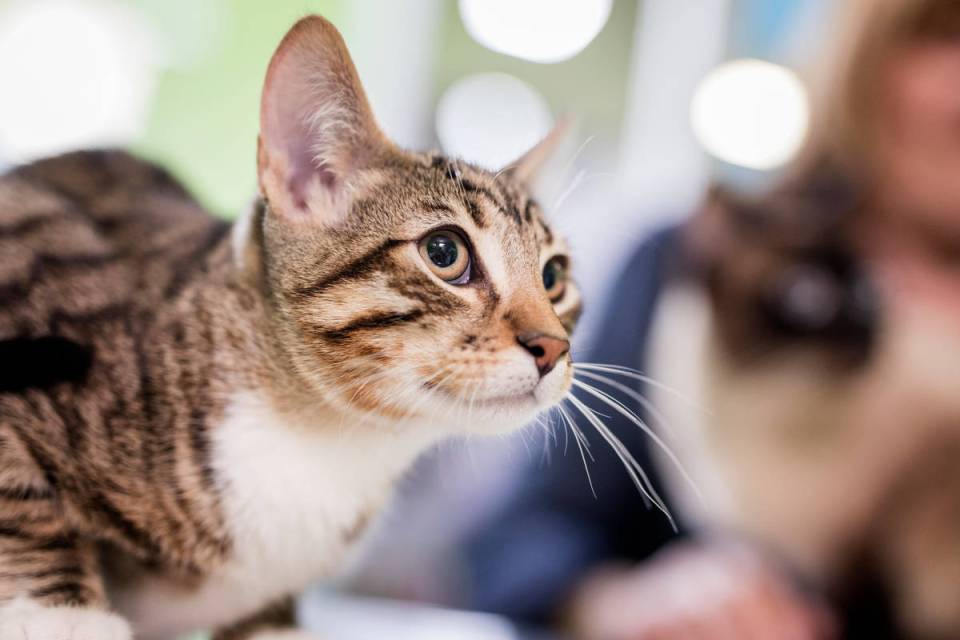
Worms
A page about worm infestations in cats describing cause, clinical signs, diagnosis and control.
Introduction
Worms are a well-recognized worldwide issue they affect pets, wild animals, livestock and even people. The majority of worms that we are concerned about are internal parasites and there are a number of different type such as Roundworms, Tapeworms, Hookworms and Whipworms. There are also a number of other non-intestinal worms which dogs and cats can suffer from, such as Lungworm.
All worms are associated with lifetime exposure risk to most dogs and cats and some of these worms can also pose a risk to people as well.
Here we will discuss the most common intestinal worms that our pets may suffer from in Ireland – Roundworms, Hookworms and Tapeworms. It must be remembered, however, that pets who travel abroad may bring back worms (and other parasites) from there that may not be endemic in Ireland. However, it is a requirement of the pet travel scheme that dogs must be wormed prior to re-entry to Ireland which provides some degree of assurance that this risk is lowered.
AetiologyThere are over 15,000 known species of nematodes (roundworm), many of which simply live in soil. However, there are a number of different roundworm species of concern worldwide as they can cause illness in animals and people. There is one main type of roundworm we are concerned about in Ireland – Toxocara cati
Epidemiology
Toxocara cati is the roundworm which affects cats. In a recent of stray cats in Ireland, 32% of the cats were shedding Toxocara cati eggs!
There are three general stages in the life cycle – eggs (known as oocysts), larvae and adults. The adult worms live in the small intestine of cats where they lay eggs and these are then passed in faeces. These eggs can remain in the environment for months or more and can act as a source of infection for other cats. Cats can also become infected by eating infected small mammals. These small mammals are known as paratenic host, meaning that the eggs can survive in these hosts, without developing into further stages. There is also unique method of transmission in kittens – they can also infected through their mother’s milk if their dam is infected.
The eggs hatch in the intestine and develop into larvae. These larvae migrate from the intestines through the liver and lungs and the life cycle is completed when these larvae are coughed and swallowed and then mature into adults in the intestines.
Clinical Signs
In the case of a low burden or in adult animals these infestations are often asymptomatic and these animals may show no signs of infestation. However, heavy infestations in young animals such as kittens may cause quite severe clinical signs including weight loss and a pot-bellied appearance. More severe clinical implications include the risk of intestinal blockage, intussusception and pneumonia.
Zoonosis
Toxocara pose a significant risk to human health. People can become infected when they come in contact with infective eggs in the environment. As infective eggs are passed in faeces litter trays, sandpits and garden are often sources of contamination. Children and people with compromised immune systems are most at risk. After a person ingests roundworm eggs, the larvae begin to migrate through different tissues – During this migration (called Larva Migrans Complex), the larvae can infect different organs such as lungs, liver, brain and eyes. The clinical signs seen can be severe such as blindness or blurred vision and seizures.
Diagnosis and Control
Although clinical suspicion might be raised based on the clinical signs seen in cats, definitive diagnosis is based on faecal analysis.
However, given the risk that these roundworms pose to our pets and family and the fact that infestations might go unnoticed it is important to follow expert treatment guidelines.
It is recommended that all pups are treated every two weeks from two weeks of age until two weeks after weaning and then monthly to six monthly thereafter, depending on your cat’s risk profile. It is advisable to always involve your vet in this decision. As kittens are infected via milk and not in utero, it is recommended to begin the regime at three weeks of age and then continue.
Nursing queens should be treated concurrently with their off-spring
All adult dogs and cats should be treated for worms at least four times a year.
However, in households with young children or immune compromised people then this should be done every four weeks.
Hookworms Ancylostoma spp
Hookworms are small intestinal worms. They are named as they have large mouth parts which are at an angle to the rest of body. There are a number of different species of note in Ireland – Ancylostoma tubaeforme (cats) and Uncinaria stenocephala (dogs and rarely cats).
Hookworm infestation in cats is considered to be very rare with prevalence estimated at 1-2%.
Adult worms inhabit the small intestine with eggs passed in faeces. These eggs develop into larvae which are either ingested or penetrate through the skin to infect new hosts.
Ancylostoma spp species can also be transmitted via milk.
Clinical signs
These clinical signs seen are due to the feeding action of the hookworms. They feed by grasping to the mucosa of the intestines and can damage the surface. The most common signs seen are diarrhoea, which is often contains blood, weight loss and anaemia. An animal that has been infected via skin penetration may also show skin lesions.
Immunity can develop after exposure though is not thought to be solid or long-lasting.
Zoonosis
It is considered to be very low risk as cases have not been reported.
Diagnosis and control
Diagnosis is made by identifying hookworm eggs in faeces. If a diagnosis of hookworm is made, that animal should be treated with an appropriate anthelmintic treatment and often these patients may need supportive treatment as well.
Control is based on regular worming. There are no specific expert recommendations for hookworm prevention as hookworm control is achieved by following expert guidelines for roundworm control.
Tapeworm
There are a two different tapeworm species that affect cats in Ireland – Dipylidium caninum- which is known as the flea tapeworm and Taenia spp. Overall prevalence of tapeworm infestation is considered to be less than 7%.
Dipylidium caninum– Flea tapeworm
This tapeworm can infect both dogs and cats. Fleas and lice are intermediate hosts to the larval stages and the adult tapeworm develops in the intestines. Proglottids are passed in faeces, these contain oncospheres; it is these oncospheres which are ingested by flea larvae and lice. Dogs and cats are infected when they ingested adult fleas or lice while grooming.

Clinical signs
Infestations are often totally asymptomatic. However anal pruritus and proglottid segments may be seen in faeces or in the coat around the anus.
Diagnosis and control
Diagnosis can be suspected based on clinical evidence of tapeworm infection but again definitive diagnosis is based on faecal analysis.
The control and management of Dipylidium caninum is centred on flea control. If infestation is suspected, or confirmed, then treatment with an appropriate worming product is required.
Taenia spp
Cats are infected with Taenia spp. by ingesting infected intermediate hosts or by eating infected meat including prey. These hosts are themselves infected by ingesting infective eggs within the proglottids. Different Taenia spp infect different intermediate hosts. Taenia taeniaeformis infects rodents and so cats who hunt and eat their prey are at risk of becoming infected with Taenia taeniaeformis.
Clinical signs.
Similar to infestations of Dipylidium caninum, infestations can often be asymptomatic. Occasionally signs of anal pruritus might be evident or proglottids may be seen in faeces or on the coat around the anus.
Diagnosis and control.
The diagnosis can be suspected given an animal’s lifestyle and habitats, such as hunting and whether (or not) it eats its prey. A definitive diagnosis is based on faecal analysis. However faecal analysis has its limitations – when identifying tapeworm species unfortunately it is difficult to distinguish Taenia spp from Echinococcus spp. Luckily Echinococcus spp are not present in Ireland.
The control of Taenia spp infestations is based around prevention of infestation and treatment of existing infestations. Unfortunately, the prevention of infestation can be a difficult goal to achieve i.e. preventing cats from hunting at all times. At risk cats should be treated at appropriate intervals. Finally, as with fleas and ticks, many worm parasites are shared between dogs and cats. Therefore it is advisable to administer anthelmintics to all animals in a household for complete control, rather than treating them at different times which may leave ongoing exposure risk.
